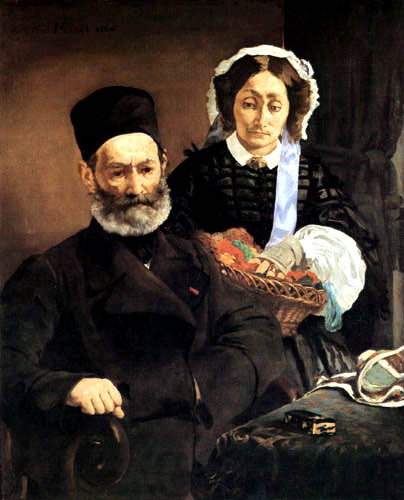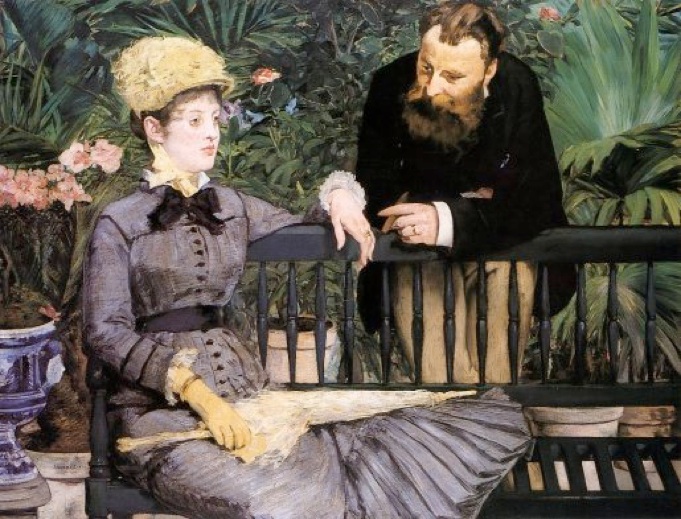the ArtJournal
march 2014












the ArtJournal
march 2014
The bourgeois couple in nineteenth century French portraiture
stories of conjugal devotion, adultery and estrangement in the art of Edouard Manet.
Maro Anesti

Edouard Manet, Portrait de M. et Mme Manet, 1869
oil on canvas, 111,5 x 91cm, Paris, Musée d’Orsay.
Edouard Manet (1832-1883) painted the double portrait of his parents Auguste and Eugenie in 1860. This work along with the Spanish Singer, was exhibited in the Parisian Salon the following year. What occurs to certain scholars as decidedly enigmatic in the specific image is that both figures avoid direct confrontation with the viewer, an element which constitutes one of the fundamental –but definitely not inviolable- conventions of portraiture as a genre.
In a brief statement he made on the painting, the artist did not mention his father’s poor state of health at the time. Nevertheless, it has been established that Auguste Manet, an eminent lawyer employed by the French Ministry of Justice where he served as a judge, was stricken with a paralysis in 1857 as a result of cerebral congestion. Quite reasonably, Nancy Locke posited that the judge’s fragile physical condition along with his inability to function mentally impelled his son to depict him as pausing or gathering his thoughts to speak. The woman’s downward gaze responds to that of the elderly man as it turns slightly to the latter’s direction: the same art historian pointed out that the painter chose to portray Eugenie withdrawing her penetrating eyes, in order to avoid an embarrassing juxtaposition of her alertness with her husband’s mental vagueness.
This portrait, like most of Edouard Manet’s works, is very ambiguous in terms of the human conditions it describes and is therefore open to different, even contrasting, interpretations. I would suggest that the full-bearded, frowning man’s staring into space renders him troubled and withdrawn rather than reflecting his contemplative mood. Furthermore his posture, with the left hand inside his black coat and the other slightly clenched on the armrest, accompanied by the reserved austerity of his face give him both dignity and authority. Following Nancy Locke’s line of thought, one could safely assume that Manet deliberately put the hands of his father in this position aiming to obliterate the signs of his disability, to hide his fragility and dependency on his wife. Yet, sometimes to conceal an element or to disguise a situation is to highlight it, either by introducing doubt and suspicion in the mind of the viewer, or by making him imagine, in the case of the painting examined here, the form of this invisible human member resting under the black vest, possibly weakened or distorted from paralysis.
The fact that Eugenie, child of a diplomat and goddaughter of Marechal Bernadotte who became king of Sweden, endured this distressful situation with the patience and dignity which befits her social position can be detected in this portrait. She stands behind her spouse solemn and thoughtful, with a serious face that denies us its gaze, participating in the misfortune of Auguste Manet which she probably experiences as her own. According to the imperial prosecutor Cordoën’s testimony in 1859, only with great effort could the judge utter a scarcely intelligible word. Mrs Manet realised the necessity of protecting her husband from being exposed. She wanted to preserve his respectability by concealing the terrible extent to which the illness had afflicted him. Thus, when the Conseil d’Etat assigned the general prosecutor Chaix d’Est Ange the task of checking into the elderly man’s state, he met this lady’s hostility. Apparently she refused any communication with him claiming that she would go directly to the Minister of Justice in response to official inquiries. Mrs Manet defended the sacred privacy of her bourgeois household, which was supposed to function as a shelter. The normal course of things that guaranteed this home’s peace and moral order was sadly interrupted when the painter’s father was compelled to resign from his position due to his infirmity. The son perceived his mother’s need to fortify her domestic environment and to maintain its threatened integrity. The turn of the family nucleus into itself is transferred in the canvas as an atmosphere of motionlessness, silence, and isolation which emerges from the typical dark background, the posture of the figures and the way these two engage with the space around them. No external stimulus seems powerful enough to draw these individuals out of their self absorption.
There is no need to state here that Manet was not a moraliser. He did not intend to demonstrate Eugenie’s moral virtues and her unquestionable conjugal devotion, or to confirm his invalid father’s imperilled patriarchal authority just in order to provide his audience with an exemplary model of bourgeois wedlock. Yet, by representing his parents sharing a downward gaze he might venture to underline the solidity of their marital union and memorialise the profound qualities of their partnership. This can be further established by the fact that although the woman’s hand is resting on her embroidering basket her eyes’ direction discloses that her inner thoughts are reserved for her companion. Only one year before this painting was completed, Mrs Manet wrote a touching letter to the Minister of Justice telling him that he would be moved to tears if he could see the expression of sadness painted on her husband’s face. The son eloquently narrates the emotional condition of his parents: the judge’s sorrow and anxiety become distress, restraint uneasiness and compassion in the figure of Eugenie. By observing the sitters we can claim that they share common sensibility and selfhood and that a bourgeois marriage was not necessarily a “monument to insincerity”. Even though during the Second Empire (1852-1870) bourgeois society did not encourage the self-image of the family as a sphere of intimacy and affection, feelings of love, concern and mutual respect could be cultivated within the domestic environment through common experiences.
What has been perceived as tension and lack of communication between the melancholic, introverted sitters might be also interpreted as a suspended ambience of decline. The ambitious, successful man’s retirement might have been experienced as a kind of “déclassement”, a situation which could jeopardise bourgeois family life, greatly dependent on the preservation of social status. That, I think, explains why Mrs Eugenie Manet requested for a six month extension of the judge’s leave hoping to postpone the inevitable. Despite the fact that Auguste Manet was never dishonoured or impoverished, the decision to abandon his duties was not taken by him. Having lost his mental faculties this man could not make a conscious choice. It was going to be his wife, who, shortly after her first attempt, realising that the old man’s condition was irreversible, wrote a final letter asking on her own behalf for his demission. The portrait was completed a few months after this incident, when Manet’s parents were trying to come to terms with totally new circumstances.
This canvas reveals a conjugal scene the painter orchestrated: “as for my mother and father I posed them in the most straightforward way, just as you see them there.” To what extent does his image correspond to the reality this couple experiences? It does perpetuate certain timeless qualities of their character, but does it also convey the shifting balances in their relationship? Mrs Manet was not a subordinated, docile person; her acquaintances talk of a dynamic and imposing woman. She did not involve her sons in the bureaucratic procedures concerning Auguste, nor did she hesitate to engage with the latter’s professional matters. Like many upper middle class women she played a decisive role in her spouse’s career. Nevertheless in the painting she is portrayed so humbly dressed that, were it not for the work’s title and her golden brooch, she could be mistaken for the maid. Possibly this is a way for the artist to show that she had become his father’s nurse and guardian ministering to all his needs. Limet, a family friend, attested that Auguste Manet could not participate in any celebrations held in his house because of his paralysis and that from now he should say that he had dined chez Mme Manet. The judge exists as a shadow who cannot converse with those around him, while Eugenie is recognised as the head of the family. Yet, her son placed her behind and not next to her husband. The artist did not rupture with every tradition, nor did he disregard all social hierarchies. The bourgeois male had to appear as the master in his own house. Accordingly, although reality was different, in this portrait the moribund father is presented more prominently, almost overshadowing his wife with his patriarchal bearded figure.
Certain art historians asserted that Auguste Manet suffered from syphilis because the symptoms he developed coincide with those appearing at the final stages of the disease. The term cerebral congestion, they stated, is only a euphemism used by the doctor to conceal an embarrassing condition which would put in peril a high ranking civil servant’s reputation, since it was linked with debauchery. Besides, Edouard Manet’s friend Philippe Burty wrote that the artist died of the same malady as his father. If we attempt to interpret the portrait considering this hypothesis valid, we will automatically start searching whether the woman’s reaction to her husband’s medical condition which forms the infallible sign of his infidelity, is by any visual means indicated via her figure.
Are the actual data distorted when one tries to make use of an artist’s assumptive intentions in order to build up an interpretation? Moreover, can the unintended consequences of a painting be a part of its meaning? The wedding ring on Eugenie’s finger is prominent, whereas the judge’s is hidden under his black coat. Can this compositional detail be perceived as the testimony a loving son bears to his mother’s fidelity contrasting it with his father’s depravity? In his letters, Leon Leenhoff claimed that the artist reserved a sort of cult for this imposing woman. Like most persons of her position and gender Mrs Manet had a conservative upbringing and was very critical towards people who violated social conventions. She made certain biting remarks regarding Suzanne, her daughter in law who gave birth to a child out of wedlock. Nevertheless she was tolerant enough to accept the young Dutch woman as her son’s spouse and live with her until the end. In my opinion it is very unsafe to analyse the specific image venturing to discover in the figure of Eugenie traces of moral reproach or wounded female pride which would derive from the causes of the judge’s illness. I also consider it unlikely that the artist would imply his mother’s disapproval of Auguste Manet’s adultery via a portrait, not only out of filial respect but because it would never occur to him. Having a mistress was extremely common among the members of the haute bourgeoisie and most wives would often tolerate similar situations for the shake of undisturbed family balance.
Although in the Salon of 1861 the portrait was greeted with a certain amount of favourable criticism, some “society” lady, an acquaintance of the artist’s parents observed that the son “made the elegant couple look like the concierge and his wife” At the same time Leon Lagrange, an art critic, wrote that the portrait forms a “travesty of filial duty”, where the young painter “tramples with even more hallowed affections”. These scathing remarks made by the artist’s contemporaries are far from astonishing. Indeed, during his career Manet sought to free himself from conventional cultural codes and he challenged sacred assumptions about ethics and human relationships. Hence, the world emanating from his images cannot be decoded according to a dominant system of values.
The portrait of an upper middle-class couple, intended to be exhibited in public, was anticipated to reflect or even formulate bourgeois ideology, delineating transparent hierarchies. However in this painting of 1860 matters concerning the figures’ social status are not conspicuous enough. The fundamental issue of class where the two sitters belong - the most decisive factor in the structuring of their selfhood - is not explicitly narrated. The same artwork becomes even more disturbing because the identity of the persons represented, so ambiguous in its visual manifestation, is evidenced through the title with which the portrait was submitted to the Salon jury. I do not argue that Manet, a self –assured upper middle class man, would ever consider implying the uncertainty emerging from the notion of the “bourgeoisie” via an image of his parents. Even more, it would be preposterous to suggest that the couple had any queries concerning either their place in Parisian high society or the nature of their bonds with its members. Still, the fluidity of the multifaceted bourgeois identity and the acknowledged difficulty to define its features might occur to us while we are observing the portrait of M. and Mme Manet. Likewise a feeling of disorder deriving from this image’s ambiguity probably puzzled those who visited the Salon in 1861. The artist denied his bourgeois contemporaries a familiar, clear stereotype of social status at a time when they search to define and embrace a solid identity.
In his work, In the Conservatory, painted four years before his death, Manet weaved a pattern of bourgeois conjugal relationships and disclosed the image middle-class people reserved for themselves. The sitters, M. Jules Guillemet, owner of an elegant dress shop at the Faubourg St- Honoré and his American born wife, a woman renowned for her taste and beauty, were both close friends of the artist. The latter has chosen to place the couple in a greenhouse, a secluded indoor area where plants can grow protected from the elements of nature. Furthermore he emphasised the figures’ marital status by putting their hands with the wedding rings almost in the centre of the composition.

Edouard Manet, Dans la serre, 1879
oil on canvas, 115x150cm, Berlin Alte Nationalgalerie.
Manet was definitely not a symbolist and one should probably avoid ascribing such intentions to him. Nevertheless Jonathan Crary, in his essay “Unbinding Vision” argues that the portrait focuses on the thematic of pressure suggested in the original title Dans la Serre. This scholar observes that the word serre derives from the French verb serrer which means to grip or to hold tightly, while, in his opinion, the flower pots and the vases constitute in their turn symbols of enclosure and instruments of domestication. In this context, the specific image could be an allegoric view of middle class marriage where love, intimacy and partnership flourish in the limited space of a greenhouse. Thus, the viewer is permitted to deduce that an ideal bourgeois wedlock, revolving its existence around conformism and comfort, can be envisioned and experienced only in unreal, constructed conditions. Additionally, In the Conservatory might introduce the idea that middle class family life, considered to be in decline or under perpetual threat, can preserve its integrity, decency and charm as long as these qualities -impeccably incorporated in the detached, elegant figures of M. and Mme Jules Guillemet- remain enshrined in a glass, artificial world similar to that of a greenhouse. However, the detachment and ambiguous emotional state of the two Parisian bourgeois who “live imprisoned in their inner monologues” emerge from the painting as if to challenge the former statement- conclusion.
So much in French literature as in painting, conservatories, those luxuriously decorated places of intimacy, are assigned with scenes of adultery and seduction. Thus, in Zola’s novel La Curée, published in 1872, young Renée Saccard’s transgressions are staged in a greenhouse. When the work analysed here was exhibited in the Salon of 1879, there were speculations on whether Manet wanted to show a legitimate couple, or the moment when two lovers, both married to different partners, secretly meet. The second interpretation seems rather precarious. However, the enchanting young woman’s absent- mindedness, her wide open eyes that stare into space and her illegible mood, could be vaguely understood as indications of her thoughts being reserved for somebody –or something- else. During the nineteenth century the bourgeois fear of being deceived by a good looking, coquettish wife who neglects her domestic duties is omnipresent. For instance, in Zola’s novel Pot-Bouille, Auguste, a shop-owner, is rendered desperate by his wife Berthe’s quotidian wandering in the city, where she spends his money in order to satisfy her endless need for clothes and jewellery in a desire to look attractive. Thus, in an emotional outburst, the frustrated husband confesses his anxieties to his insensitive mother-in-law: “Mais votre fille finira par me tromper!” His ominous words will shortly be confirmed. Berthe’s character and deficient moral instruction, her attachment to worldly life – in sum her depraved mentality - lead her to adultery. The lady represented here in a walking dress, was according to her contemporaries a fashionable woman of the world. Manet did not depict her as a housewife or a mother, probably because these cherished qualities were not the most decisive in the structuring of her personality. Nevertheless, whether or not the portrayed man’s posture and his downcast expression render him overwhelmed by a fear similar to that of Auguste in Zola’s novel, constitutes only a speculation which cannot be established.
The couple’s physical separation by the back of a bench where the woman is seated, along with their crossing sightlines were elements recurrently construed as signs of estrangement. Even if the artist attempted to show a marriage suffering from lack of affection and mutual concern, he refused to point out who is to be blamed for this. According to several critics, Manet, in most of his portraits, ventured to divide responsibility for alienation between men and women. Bradley Collins affirmed that “In the Conservatory there is no marital euphoria or marital discord. Since all elements of narrative time are removed, we cannot intuit the preceding action nor can we foresee the future”. This is not peinture de genre, and therefore it does not subordinate to its formulas. Manet disclosed here the experience of bourgeois body, social and privatised, conformed and uneasy, enchanting both in its restraint and its ambiguity. The sitters’ disposition corresponds to those rules that shape modern society, which is dominated by their class. Thus, as the art critic Jules Castagnary said “Nothing is more natural than their behaviour.” The differences emerging from their posture and emotional outlook could be attributed to the qualities of their gender, while the image of their marriage articulates middle-class hierarchies, highlighting those contradictions that interweave with bourgeois world’s structures.
Mrs Guillemet is shown to us in a kind of daydreaming. Motionless but not passive, she is probably indulging in the self- conscience of her Parisian feminine charm, fortified in a private sphere which is hard for the viewer to define, though it stands clearly apart from the one her spouse is inscribed to. Her adornment renders her to us contently indifferent, a blossoming entity growing inside the sheltered universe of her wedlock, a physical continuum of the abundant vegetation surrounding her and her partner. I would not agree with the suggestion that her corset, ribbons and bracelets should be read as “signs of compression” - material things which suffocate her. They rather form emblems of the bourgeois female identity she happily embraces. In this depicted fragment of a marital relationship captured by Manet in Dans la serre, the viewer might also perceive a flirtatious atmosphere, a mutual erotic play subordinated to bourgeois etiquette. Jules Guillemet, bearded and black vested like a typical incarnation of his class’s members, bends over the bench where his charming wife is seated, and turns slightly his head towards her. One of his hands is hidden, whereas the other, holding a cigar, approaches as if purposelessly the delicate hand of his partner, who has removed her glove, maybe waiting to receive his caresses; these two persons are physically very close but they do not touch each other; a potential tender gesture is bound to be eternally suspended. Was Manet reluctant to represent a moment of conspicuously manifested passion between his two friends, or did he wish to be sincere towards the refined, sophisticated ways of his own class’s members whose feelings are suggested rather than openly expressed? Did he venture to portray the arrogant behaviour of the dandy who “does not consider love as a special aim in life” juxtaposing it with the haughty narcissism of Mrs Guillemet? Even if Manet decided to censor himself by concealing the warmth of his sitters’ passion, his painting implies that upper middle-class marriage was not the cemetery where sexual desire was buried. Aphorisms such as: “bourgeois wives were competent housekeepers, doting mothers and erotic disasters” or “where bourgeois love they do not desire, where they desire they do not love” are oversimplified conceptions.
The detachment of the sitters, observes Jonathan Crary, results from their belonging to the modern world whose fluid essence is incorporated in their existence. Being themselves inseparable parts of a constantly changing urban environment, they absorb and reflect its ambiguity. In a certain way, their intentions and desires, their self image and the qualities of their conjugal life form this complicated system of accumulated notions, this partly historical, partly metaphysical and infinitely vague condition which is called modernity.
When the portrait was exhibited in the Salon, art critics were struck by its unusually polished brushwork impressively accented in the head of young Mrs Guillemet. Was Manet making concessions to the public, as Castagnary ironically remarked, or are the reasons for his “artistic conversion” even deeper? Did he, through the contained outlines of a beautiful female face, imply that a bourgeoise wife as he envisaged her conformed to the dominant reality of her socialised body? Did he suggest that his model resisted connection with anything outside her body’s articulated hierarchy? Was he, by using visual means, struggling to avert experiences of disintegration and maintain the viability of a universe ready to fall apart? Does he identify himself with Mrs Guillemet, conveying via her figure his personal anxiety for the present and the future of his world? It is hard to know whether the former questions can help us realise the painter’s true intentions which might as well lie outside any complicated theoretical schemes. Probably Manet was simply enchanted by this lady’s appearance and the unusual perfection of his technique should be understood as the impact of his male admiration. Maybe he was prompted to return to the qualities of a classic artistic tradition, in order to record this delicate face’s features in all their grace and charm.
A factor which provides the viewer with important information concerning the represented woman’s ethos in this painting is her dress. Fashion interweaves with morality, as excessive luxury does with corruption. In 1875, in his book “L’art dans la parure et dans le vêtement”, the art critic Charles Blanc observed that after the establishment of the Second Empire, everything that could keep women from remaining seated was encouraged, whereas anything that could have impeded their walking was avoided. Furthermore, the same author correlates the new feminine attire with the progressive weakening of family ties. Obviously, a woman who is wandering in the city boulevards free and undisturbed does not have time to concentrate on the affairs of her house. From the moment she ceases to be “an angel of the hearth”, she cannot be highly regarded. It has already been mentioned that Mrs Guillemet, though seated on a greenhouse’s bench, is posing for Manet wearing a comfortable walking dress. Her clothes render her neither destined for a secluded, sedentary life, nor conformed to the rules of domesticity. On the contrary, the depicted married lady appears to transgress this cherished moral canon without being afflicted; she evades the female state of enclosure without being introduced to the viewers as a fallen woman. Respectable and confident, she is prepared to get out of the greenhouse and engage herself with the stimulating experiences of the urban environment. In the Conservatory, as a work of art, is deeply associated with the idea of fashion which “comprises the outward criterion for judging whether or not someone belongs in polite society”. Mr. Jules Guillemet owned a dress shop and his good-looking wife designed clothes. Thus, they both form conjoined members of the world of fashion and they disclose the idea of the “enthronement of merchandise.” Their social status and existence was based on the ideas of consumption and exchange, two notions which structure and dominate the bourgeois world keeping this latter alive and at the same time undermining it.
The portraits of married couples express the spirit of Manet’s era; the nineteenth century characteristically focused on conjugal relationships. Marriage served innumerable functions and was seen as the vital cell of human society because it comprised a device for procreating, meeting sexual needs and fulfilling class expectations. Certain subjects related to wedlock haunted French society; thus, during the Second Empire (1852-1870) and the Early Third Republic (1870-1900) literature was brimming with stories of adultery and venereal diseases, marital discord and estrangement. From Flaubert to Zola and Maupassant, the misfortunes of marriage were an inexhaustible source of inspiration. Furthermore, nineteenth-century men of state, philosophers and physicians with different ideological backgrounds wrote books with guidelines in an attempt to moralize and fortify this sacred institution. It has been pointed out that Edouard Manet was not a genre painter who would describe straightforwardly the marriage etiquette of bourgeois society or castigate the transgression of moral rules. However, these two works render him a child of his time; they allow us to raise fundamental questions concerning nineteenth-century social class and hierarchy, family structures, gender roles and middle-class ethics.
Bibliography
1 Ariès Philippe, Duby Georges et Perrot Michelle (eds.), Histoire de la vie privée: De la Révolution à la Grande Guerre, vol.4 Paris 1999.
2 Benjamin Walter, (ed. Tiedemann Rolf) The Arcades Project, Cambridge Massachussetts 1999 (transl. Howard Eiland and McLaughlin Kevin).
3 Blanc Charles, L’art dans la parure et dans le vêtement, Paris 1875.
4 Collins Bradley, “Manet’s In the Conservatory and Chez le Père Lathuille, Art Journal, 45, no 1, (Spring 1985) pp 59-66.
5 Crary Jonathan, Unbinding Vision, October, vol. 68, (Spring 1994) pp. 21-44.
6 Daumard Adeline, Les bourgeois et la bourgeoisie, Paris 1987.
7 Fried Michael, Manet’s modernism, or, the face of painting in 1860’s, London 1996.
8 Gay Peter, The bourgeois experience: From Victoria to Freud, vol. 2, New York and Oxford 1984.
9 Habermas Jurgen, The structural transformation of the public sphere, Cambridge 1989 (trans. Thomas Burger).
10 Herwitz Daniel, The Work of Art as a Psychoanalytical Object: Wollheim on Manet, The Journal of Aesthetics and Art Criticism, 49, no.2, (Spring 1991) pp. 137-153.
11 House John, The Hidden Face of Manet, The Burlington magazine, April 1986 pp.1-19.
12 Kern Stephen, The Eyes of Love, London 1996.
13 Locke Nancy, Manet and The Family Romance, Princeton and Oxford 2001.
14 Reid Roddey, Families in Jeopardy, Regulating the Social body in France, Stanford, California 1993.
15 Tabarant Adolphe, Manet et ses oeuvres, Paris 1947.
16 Wilson- Bareau Juliet (ed), Manet by himself, London 2004.
17 Wivel Mikael, Manet, Catalogue Ordrupgaardsamlingen, Copenhagen 1989.
18 Zeldin Theodore, A history of French passions, Ambitions, Love and politics, vol.1, Oxford 1993.
19 Zola Emil, Pot- Bouille, Paris 1886.